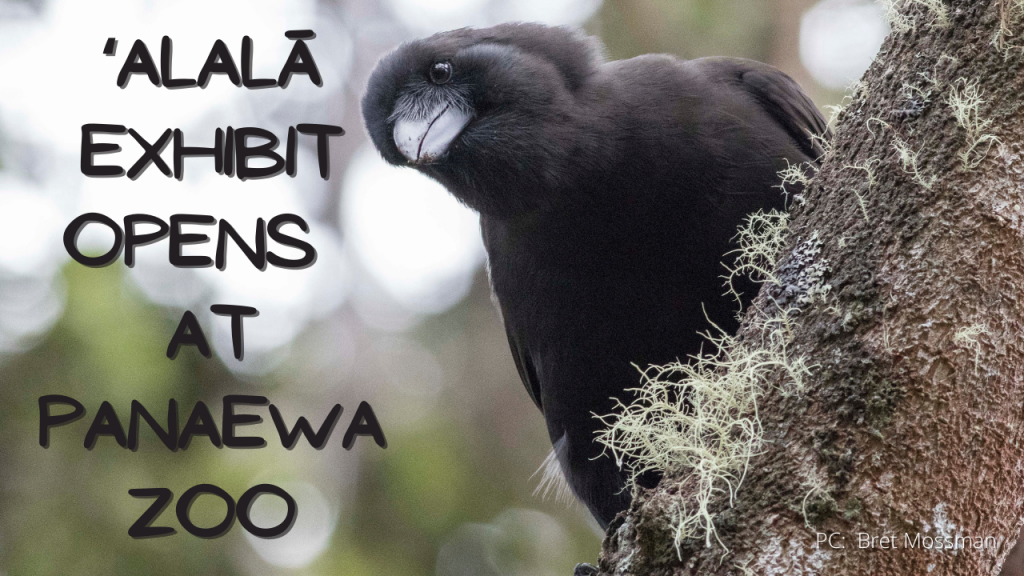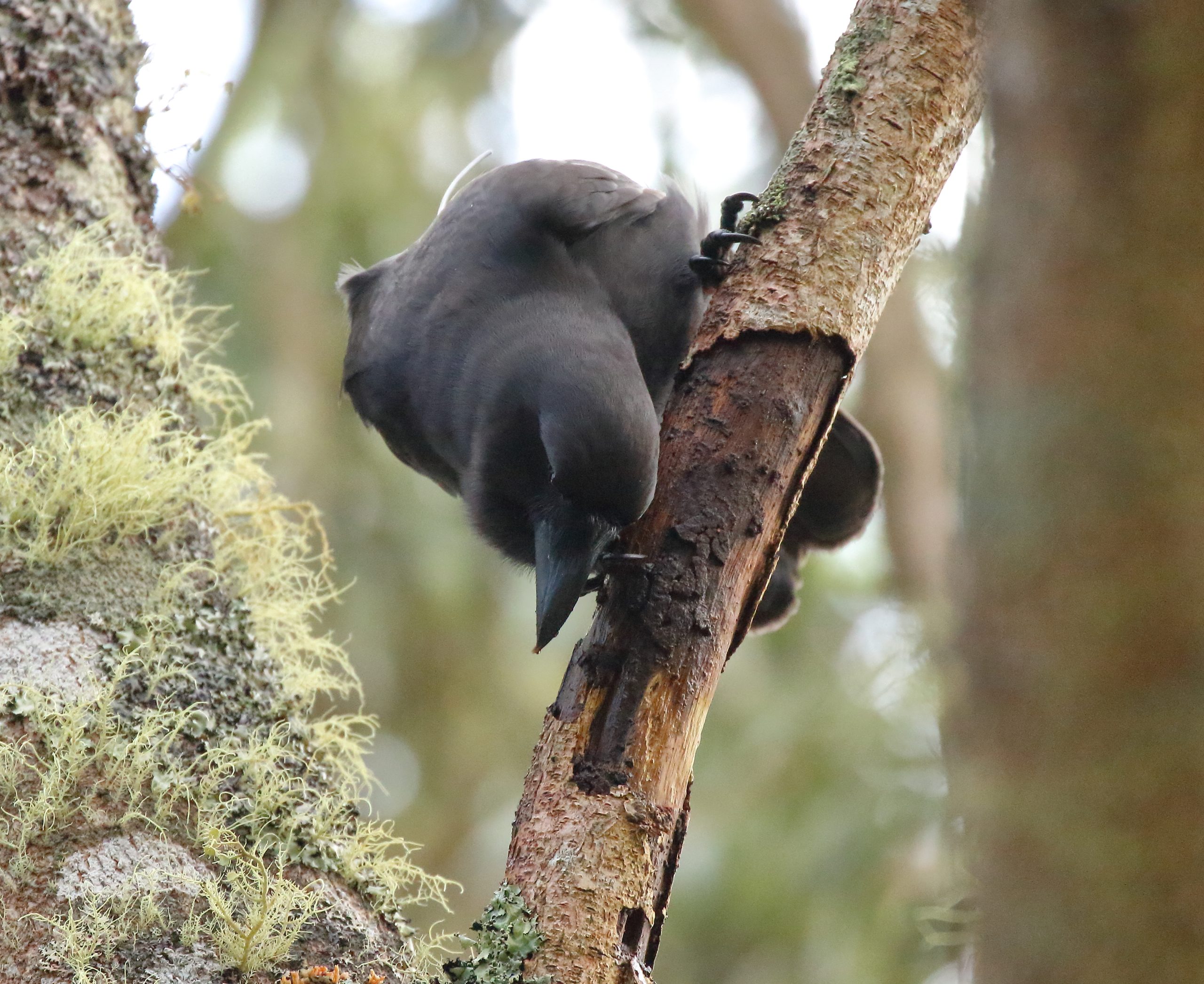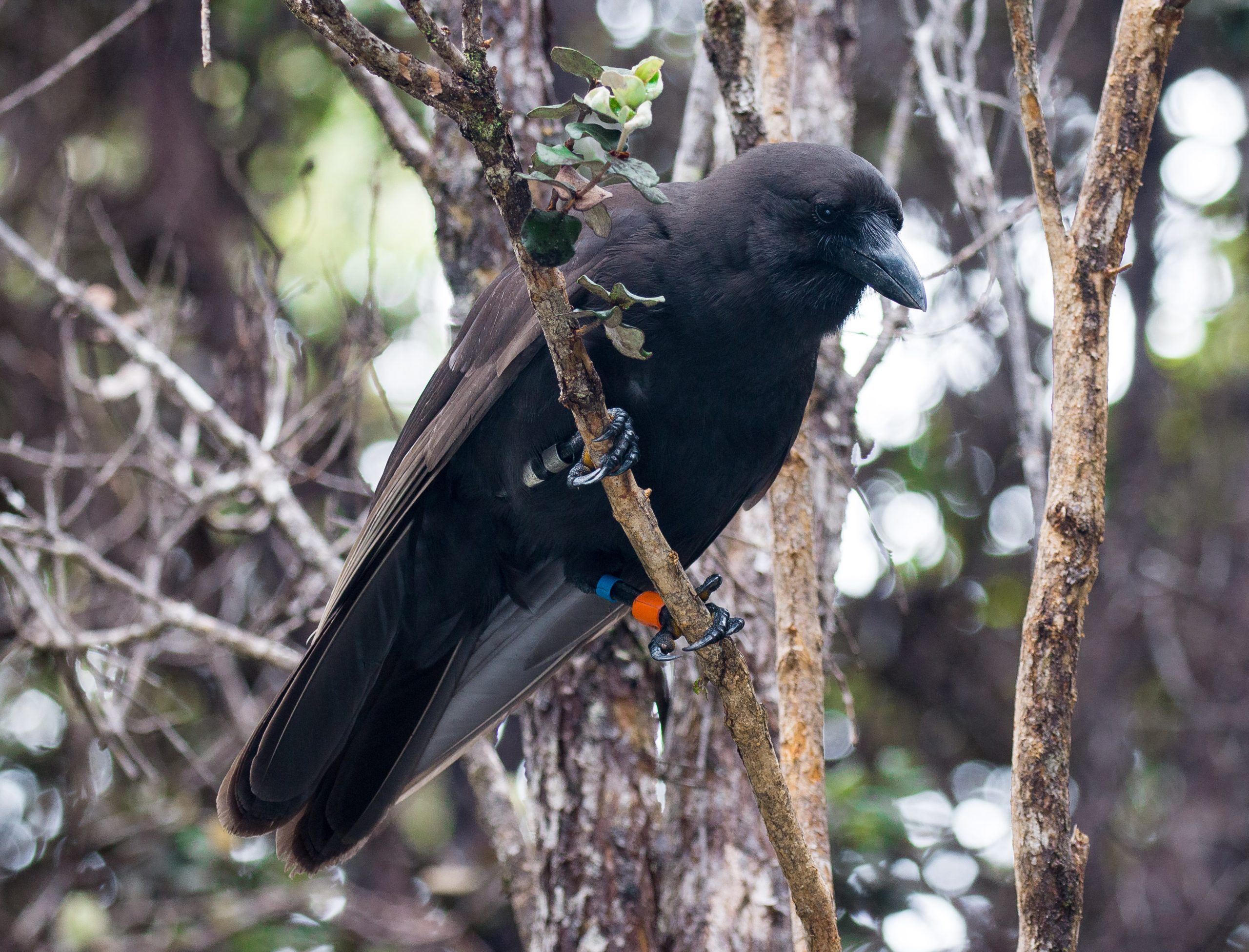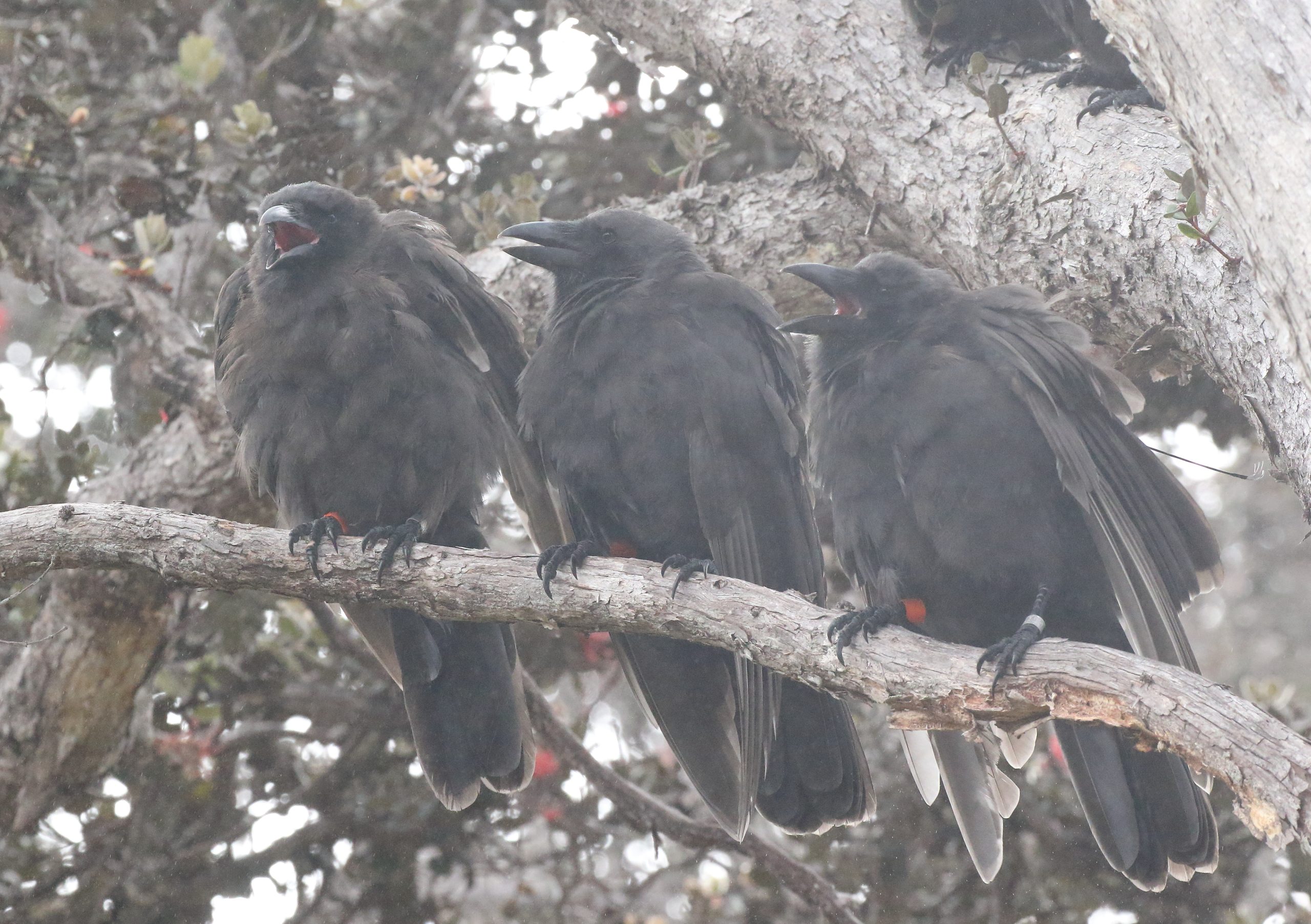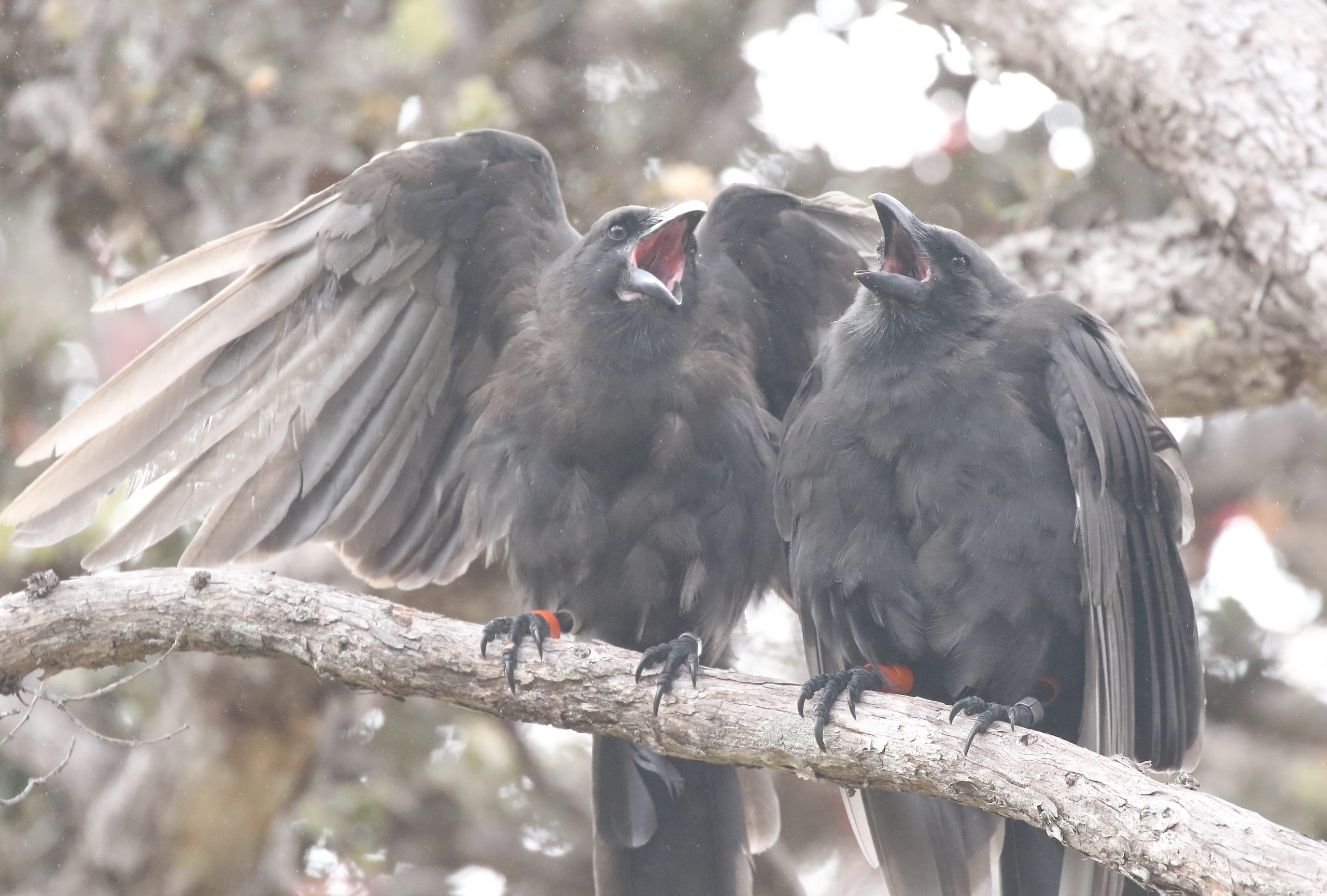ʻAlalā

Names
- ʻŌlelo Hawaiʻi: ‘Alalā
- Common: Hawaiian Crow
- Scientific: Corvus hawaiiensis
Conservation Status
- Federally Listed as Endangered
- State Listed as Endangered
- State Recognized as Endemic
- NatureServe Heritage Rank: GXC-Presumed Extinct/Captive Population
- IUCN Red List Ranking—Extinct in the Wild Revised Recovery Plan for the ‘Alalā —USFWS 2009
Species Information

ʻAlalā. PC: Bret Mossman
Historically at least five crow species (Family: Corvidae) occurred in Hawai‘i, only the ‘alalā, or Hawaiian crow survives. Like other crows, ‘alalā are loud and sociable. ʻAlalā are the largest surviving endemic Hawaiian forest bird. They weigh about 1 pound and are over 1.5 feet long from bill to tail. They make incredible human-like cries, screams, and moans to communicate with each other. ‘Alalā have a life span of 20 or more years in a captive setting. In the wild, the oldest documented bird was 18 years old. The diet primarily consists of native and introduced fruits, invertebrates, and eggs and nestlings of other forest birds. Their diet can also contain nectar, flowers and carrion. ʻAlalā are ecologically important as a seed disperser for many native plant species. Historically, seasonal movements in response to weather, breeding season, and availability of food plants (e.g., ‘ie‘ie [Freycinetia arborea]) have been noted. ʻAlalā are a highly social and intelligent species. They occur primarily in pairs or family units and have been known to form lifelong social bonds with each other. They develop a social hierarchy at a young age (approximately 1 year). Nests are predominantly constructed in ‘ōhi‘a (Metrosideros polymorpha) trees. Both the female and male participate in nest construction, although only females incubate eggs and brood young. Clutch size ranges from two to five eggs, but usually, only one or two nestlings fledge. Fledglings typically do not fly well and can remain near the ground for periods of time, which can increase their susceptibility to disease (i.e., toxoplasmosis) and predation. Juveniles depend on their parents for at least eight months and remain with their family group until the following breeding season. Large flocks, characteristic of American crows (C. brachyrhynchos) have not been reported, but there are historical reports of small local flocks after the breeding season.
(UH PCSU, 2021)
Distribution
Due to a variety of threats in the wild, these birds are considered extinct in the wild and can currently only found within a conservation breeding program or at the Panaʻewa Zoo. There are over 100 birds within the population (UH PCSU, 2021). Release efforts were conducted from 2016-2019 in the Puʻu Makaʻala Natural Area Reserve on Hawaiʻi Island. Historically occurred in high- and low-elevation forests of the western and southeastern regions of the island of Hawai‘i.
Habitat
Historically, ‘alalā occupied dry and seasonally wet ‘ōhi‘a and ‘ōhi‘a/koa (Acacia koa) forests between 300 and 2,500 meters (1,000 – 8,200 feet) elevation. Because the last wild individuals were confined to a small subset of the species’ former range, specific knowledge of key habitat requirements is unknown. Currently, all potential habitat is degraded. The presence of non-native mammalian predators and birds, which can act as disease reservoirs, further reduces habitat quality. Core areas of the species’ former range are now managed by the State of Hawai‘i and the U.S. Fish and Wildlife Service.
Threats
Alalā are likely susceptible to the same factors that threaten other native Hawaiian forest birds, including: loss and degradation of habitat, predation by introduced mammals, and introduced disease. For ‘alalā populations, the following are of particular concern:
- Predation. The small Indian mongoose, rats, and feral cats prey on ‘alalā. The ‘io (Buteo solitarius) also prey on juveniles and adults and is the only known natural predator of ʻalalā (UH PCSU, 2021).
- Shooting. Many ‘alalā were killed around farms between 1890 and 1930. Despite legal protection in 1931, the shooting of individuals occurred into the 1980s.
- Disease. Population declines were noted between 1890 and 1910, a period when other native bird populations declined, presumably because of mosquito-borne diseases. Seasonal movement may have increased exposure to diseases. In addition, ‘alalā are susceptible to toxoplasmosis carried by feral cats.
- Habitat degradation. Habitat conversion by human activity as well as by grazing ungulates has severely degraded former ‘alalā habitat. These changes may have limited food or nesting resources and may have increased the vulnerability of ‘alalā to predation by ‘io. Conservation agencies have been working for many years to protect and restore native Hawaiian forests on multiple islands that ʻalalā can someday call home (UH PCSU, 2021).
Explore from Home
Plans & Projects
- Final Environmental Assessment for the Pilot Release of ʻAlalā (Corvus hawaiiensis) on East Maui, Hawaiʻi (Jan 2024)
- The ʻAlalā Project
- Maui Forest Bird Recovery Project (MFBRP)
- Hawaiʻi Endangered Bird Conservation Program (HEBCP)
Additional Resources
For more information and references visit the DLNR State Wildlife Action Plan factsheet. DOFAWʻs species pages and State Wildlife Action Plan fact sheets are provided for general information and are not meant to be a citable, original source of data. If you are a student, researcher, or writer looking for a citable source, please explore the references below or find other original data sources, rather than citing these webpages. The references below were provided by the authors of the State Wildlife Action Plan fact sheets at the time of drafting:
- Banko PC, Ball DL, Banko WE. 2002. Hawaiian crow (Corvus hawaiiensis). In The Birds of North America, No. 648 (Poole A, Gill F, editors.). Philadelphia, (PA): The Academy of Natural Sciences; and Washington DC: The American Ornithologists’ Union.
- Berger AJ. 1981. Hawaiian birdlife. Honolulu: University of Hawai‘i Press. 260 pp.
- IUCN Red List of Threatened Species. 2015. Version 2014.3. Available at: www.iucnredlist.org. (Accessed May 2015).
- U.S. Fish and Wildlife Service. 2009. Revised recovery plan for the ‘Alala (Corvus hawaiiensis). Portland, (OR): U.S. Fish and Wildlife Service. Xiv+105 pp.


